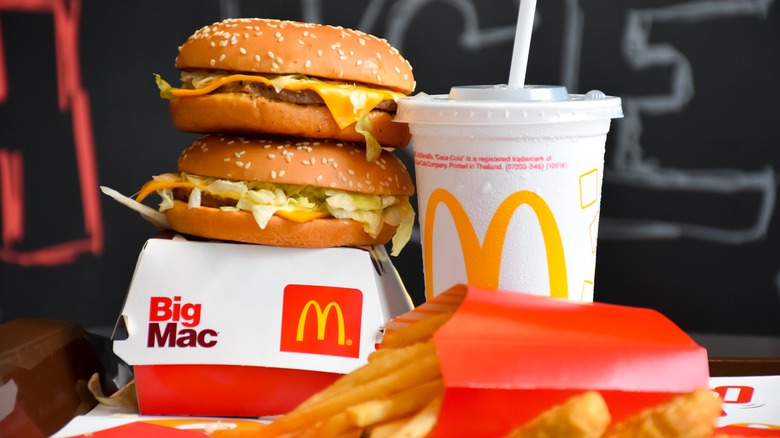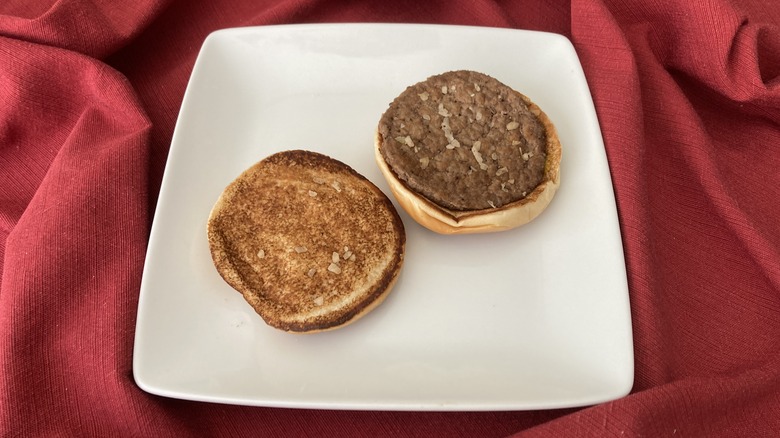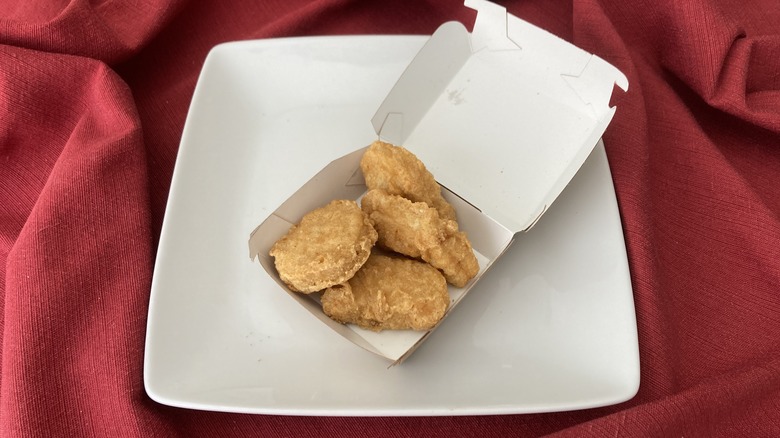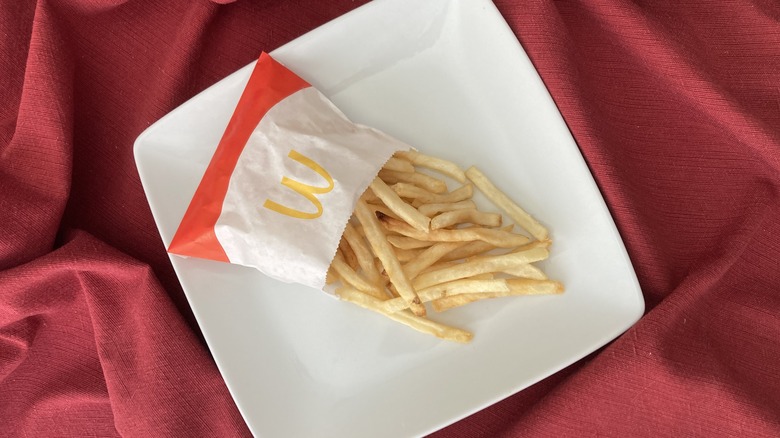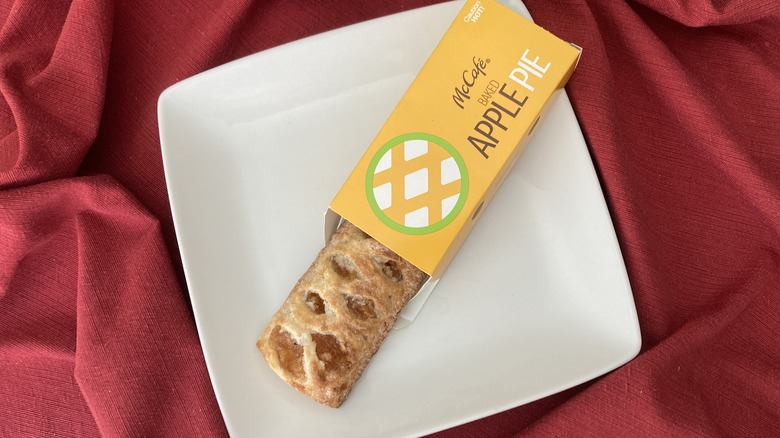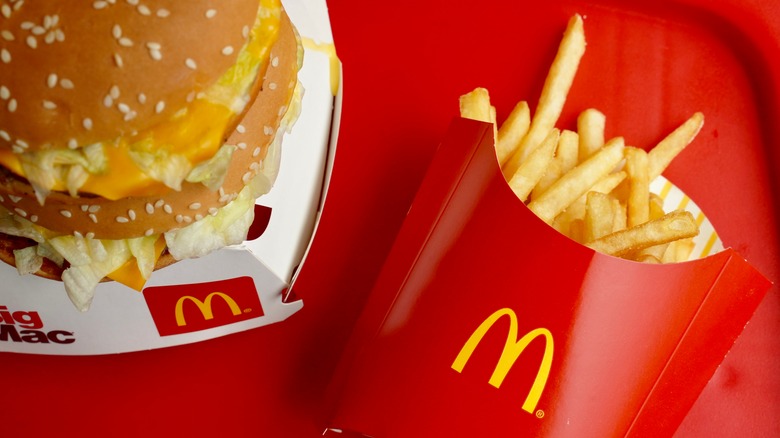Here's How Long Popular McDonald's Items Really Last
Have you heard the one about the McDonald's hamburger that was unwrapped after 24 years and it still hadn't begun to rot? It's a joke with a pretty gross McDonald's punchline, considering the world's most popular fast food restaurant has somehow created Frankenfood items that retain their original traits no matter how old they get. Surely something on the menu must surrender to the pull of entropy at some point and either grow mold or shrivel up into oblivion ... right?
The only way to know for sure is to buy up a bunch of popular McDonald's items and watch them as they deteriorate — or don't deteriorate, as the case may be. We chose a broad variety of sandwiches, sides, and sweets from all sections of the menu and laid them on the table to see what actually happens to fast food when nobody is watching. Do your favorite McDonald's items remain intact forever, or is there a point at which they wither away? It was an unappetizing experiment to undertake, but once it started, the fast food fascination took over and we couldn't wait to see what happened next.
Classic Hamburger
A true fast food champ can down a classic McDonald's hamburger in a few bites, eliminating the possibility of leftovers. But what if you overbuy and stick the remaining burgers in the fridge for later? Or maybe your kids didn't finish their burger Happy Meals and you're hoping to get future dining out of the deal. How long will it be before the Burger That Doesn't Rot becomes at least unappetizing, and at most inedible due to dryness or strange ingredient separation?
Our original burger was fresh and hot when we picked it up and snapped a photograph of it. Then, we interred it in the ice box and let it sit for the better part of a week before checking on it. Refrigeration had kept it intact, but it certainly didn't appear inviting enough to eat straight out of the bag. In the past, we would have engaged a little microwave rejuvenation and a few tweaks like new pickles and condiments to bring this morsel back to life sufficiently for a quick snack. So we put it back in the bag and left it for another three weeks, just to see what would happen. What emerged from the wrapper was a petrified version of the original burger, solid from bun to patty, with onions that had almost shrunken down to oblivion.
Verdict: A classic burger lasts less than a week.
Quarter Pounder with Cheese
McDonald's beef patties have always been questionable, even before the 24-year-long burger discovery was made. But what if you encase the so-called meat in sort-of cheese, pickles, and a few rings of fresh onion? Would the cooperative nature of a dairy-adjacent slice extend the freshness and help a burger like the beloved Quarter Pounder with Cheese live a longer life before you get a chance to dig in? It would be naive of us to believe so, but we can't predict everything.
Though the sandwich in the bag only ever bears a passing resemblance to the photo on the menu, our QPC at least looked like a somewhat-robust dish when we got it home. After a week, the bun was locked into a petrified state, but the meat was still mid-contraction, a phenomenon we noticed that makes the beef disk smaller and tough like a hockey puck without altering the surface texture. It turns out the cheese just locks into place like a slab of vinyl somewhere along the line. The term used in the world of Internet Food Science for that kind of thing is "Ew."
Verdict: You may get a few days' life out of a Quarter Pounder with Cheese.
Chicken McNuggets
Knowing that McNuggets are actually made of batter-fried ground white meat, it wouldn't be wrong to believe that these whimsically shaped bites could survive a few weeks in the fridge without becoming entirely inedible. After all, grocery store freezer sections are filled with frozen nuggets of all sorts that only need a bit of time in the oven to become hot and tasty. Why shouldn't you expect a McNugget that has been previously delicious to last if kept in the box and stored cold?
Surprisingly, you may be able to get a few days' out of a box of McNuggets and with a reheat in a traditional oven or a toaster oven find them to be relatively intact. This is longer than we expected them to be even somewhat okay. We discovered that holding onto them any longer results in a rock-like texture and a visibly gray cast seen under the breading. They end up resembling oversized mutant walnuts, littered with lumpy grooves and a bit smaller than they started out, thanks to dehydration. Rather than hoping to resurrect this Frankenfood item after it's been allowed to cool for less than a week, it would be advisable to just buy a new box and call it even.
Verdict: McNuggets can stick it out for two days tops without raining down misery on your Happy Meal.
Sausage McMuffin
If you're grabbing a Sausage McMuffin on your way to work, it's always wise to eat it quickly so the egg layer is as fluffy as possible, and the sausage hasn't had a chance to develop a waxy skin of congealed oil. So you can imagine how unfortunate it would be to pick up a Sausage McMuffin that had spent a week in cold storage, let alone an entire month. We hoped that maybe the English muffin — one of the toughest bread items in the bakery — might offer some sort of defense that would let the sandwich last beyond sundown.
We were fooling ourselves. The sausage patty had become rubbery by the end of day one. By the end of the whole week, we couldn't make the bread or the meat move by pressing on it. The cheese looked even more plastic than it had when the sandwich was new, and the eggs were ... Well, let's just say eggs were never meant to go through this much trauma. When week four rolled around, the whole situation was sadly laughable, or laughably sad. Either way, that "eat it quickly" philosophy is no joke; Sausage McMuffins aren't made to last beyond the first shift.
Verdict: A Sausage McMuffin lasts through the morning, but not much longer.
McChicken Sandwich
You might think that having a protective coating of fried breading and a nest of lettuce would help a McChicken sandwich stay intact for longer than a burger. That would be wishful thinking. It turns out the crusty sheath does nothing to preserve the integrity of the sandwich, though it does maintain the appearance well enough to fool unsuspecting eaters into thinking their sandwich is still worth digging into.
Two days in, we could tell this wasn't going to be a long-laster. After a week under refrigeration, the previously hot and crispy patty was nearly fossilized in a way that couldn't be reversed. Beyond that, it became tougher than jerky and resembled a sanding block. By the end, we weren't sure if we should toss it out or use it to refinish our patio overhang. Just kidding; we knew it was destined for the trash bin.
Verdict: A McChicken Sandwich lasts two days, tops.
Filet O' Fish
The hopes for a Filet O' Fish sandwich to last any longer than the day you buy it seems unreasonable. The chopped patty is a glorified fish stick made of Alaskan Pollock according to the menu, served on a bun with a blast of mayonnaise-based tartar sauce and a stingy half-slice of cheese. It's the most modest version of a seafood favorite that lends a little diversity to the McDonald's menu, and it seems to be adored by enough diners to keep its place in the line-up. But you wouldn't expect it to get very far if you can't finish it in one sitting, would you? That would be hoping for too much.
You would be correct in thinking Filet O' Fish is an eat-now item. We found the patty to have hardened past the point of comfort within the first three days, with the bun following close behind. The cheese went entirely leathery sometime after that, and the tartar sauce became translucent, like a ghost of its former self with relish suspended in the center. We resisted the temptation to press on it and see if it had become gummy. There's only so much we're willing to put on the line for the sake of science.
Verdict: Consider Filet O' Fish the catch of the day, because it doesn't last much longer than that.
Fries
If you've ever stuck a bag of McDonald's fries in the fridge to enjoy down the line, you'll know that these are the most fragile members of the menu when in storage. In fact, fries are usually the first things to expire when you leave your value meal sitting for too long. The time between enjoying them fresh and hot and finding them to be like solid potato matchstick isn't a huge duration. So if you can't depend on them to be crisp and chewy when they're fresh out of the bag, what could you possibly expect when you've left them sitting in the fridge for several weeks?
We found our iconic McDonald's fries to be completely inedible within the first 24 hours of being stashed away in cold storage. Anyone who has hoped to keep their extra taters until they're ready to reheat and eat will understand the disappointment of discovering that McDonald's fries do not reheat nicely, either. Sometimes they stay solidified like matchstick potatoes, and sometimes they turn soft and greasy and impossible to eat without making a mess. We were lucky to get them past the first day without losing our appetite. After that, we lost all hope.
Verdict: Fries last a day in the fridge, if even that.
McFlurry
The McFlurry was probably the one menu item we had no hope of lasting through the experiment. It's the most perishable item on our list, and being such, it demands to be enjoyed within the first few minutes of hitting the cup. Putting it in the freezer would suspend it in its current state indefinitely, and we couldn't see the fun or discovery in that. But what if we popped it into the fridge instead to keep it soft and edible rather than letting it freeze solid? Would it at least retain its creaminess for a day or two if we applied lower temperatures before it melted?
It turns out our McFlurry didn't last beyond the ride home. We took it out of the bag to discover that the contents of the once-filled cup had deflated to be three-quarters full instead. Evidently, all the whipping that goes into making McDonald's soft serve light and fluffy also makes it supremely delicate. After another few days, the cup was approximately half full and had separated into a strange greasy mix. Naturally, soft serve isn't going to last very long, even from McDonald's. But seeing this one go from light and lively to sad and schlumpy in a matter of minutes was surprising. Suffice it to say, it doesn't last at all, really, so eat it quickly.
Verdict: A McFlurry lasts only a few hours.
McCrispy Chicken Sandwich
The last thing we would have expected was a McCrispy Chicken sandwich to survive longer than the rest of the food in this experiment. If you can keep the majority of the burgers from succumbing to entropy aside from turning rock-hard, how can you hope to retain the freshness of the closest thing to natural food this chain serves? Shouldn't that be the first to fall victim to mold, or change texture at the very least? Our hypothesis was that yes, this Chick-fil-A copycat would be toast when we checked in on it.
Lo and behold, it was oddly okay when we checked in the first time. And it was still faring pretty well when we opened the wrapper again. But at the end of the experiment — four weeks after purchase — the McCrispy Chicken was still moist, and the bun was soft and pliable. Condensation had collected on the inner surface of the wrapper, which may account for the seemingly edible texture. The best guess we have as to why this sandwich did far better than any of the other items on the list is that the wrapper is made of foil, which likely prevents hardening due to its non-porous nature. Nonetheless, it was a strange surprise that made us laugh out loud with all the excitement that mad food science experiments inspire.
Verdict: A McCrispy Chicken sandwich seems to last beyond the four-week point, though edibility is in question.
Baked Apple Pie
If anything was going to seize up and turn inedible, a Baked Apple Pie from McDonald's would be the prime candidate. These fried confections are really only appetizing when they're fresh out of the fryer. Even when they turn cold, they have a tendency to become greasy and gross. It may say "baked" on the label, but we could practically see the shortening seeping out of the crust when it was fresh out of the box. That didn't bode well for the durability, though the strange gel the apple filling was suspended in did seem to provide a sort-of glue to hold things in place, so who could really tell.
Well, this is one apple pie you want to eat as quickly as possible. By the time it had cooled, it was already a no-go. After a week in the fridge, it had tightened up like a crusty tube and the gel had stiffened. By week four, tension had set in fully and the oily residue had become a crumbly film that made us wonder why we ever liked these things to begin with. It was equally delightful and disappointing that our prediction turned out to be accurate. If you're an apple pie fiend, don't let the sun set on your purchase. Diehard McDonald's dessert fans are sure to know this already.
Verdict: Baked Apple Pie lasts hours before starting on the path to No-Goodsville.
How we tracked our items
This may have been the easiest food science experiment in the history of eating. It was a simple case of purchasing all the items — options representing as many menu categories as possible — and watching them deteriorate. It sounds nasty, but to replicate a real-world scenario, everything was kept in its original packaging and stashed in the bag it all came in. We had periodic check-ins and opened the wrapper to see how the fare was faring, and because of the long-lasting nature of McDonald's food, we gave each item the finger test to see if the texture had changed. The one thing we didn't do was take a bite; even curious food scientists have standards.
While most of the items showed signs of solidifying early on, some were too delicate to last beyond the first day, with fries, McFlurry and Baked Apple Pie showing quickest signs of surrender. The sandwiches were unsurprisingly durable, though that durability quickly turned into inedibility past the one week mark in most cases. The sleeper in the sack, the long-lasting McCrispy Chicken sandwich, may have had the most protection from deterioration thanks to its protective foil pouch. Despite the fact that it remained soft and seemed largely undamaged after a month under refrigeration, prevailing wisdom says the presence of bacteria can't always be gauged visually. In short: We considered nothing to be edible by the end of the experiment.
